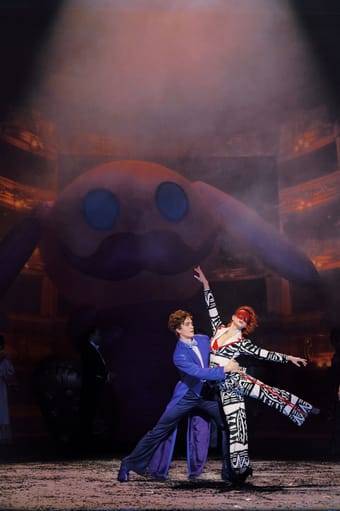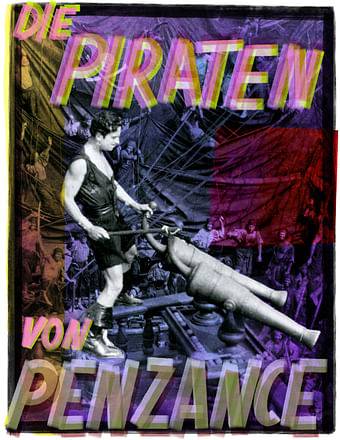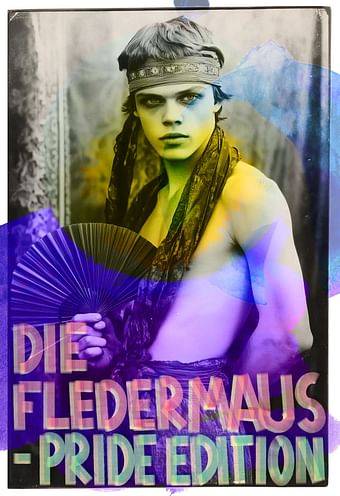The operetta A Night in Venice, composed in 1883, drew on the overflowing enthusiasm that Vienna held for the Serenissima — an affection that reached another peak with the opening of the “Venice in Vienna” theme park in the Prater in 1895.
The plot revolves around the pleasure-seeking Duke of Urbino, a notorious womanizer, who wishes to take advantage of the Carnival season to pursue a romantic conquest under the cover of colorful masks and disguise… Specifically, the Duke sets his sights on Barbara, the wife of Venetian senator Delaqua. Several schemes — some aiming to thwart the Duke’s plan, others to support it — intersect and clash, and in the end, the Duke finds himself facing not one, but three Barbaras!
Dutch director Nina Spijkers, who previously staged The Merry Wives of Windsor at the Volksoper, takes on the production and sets out to explore the work’s escapist and hedonistic potential.
With the kind support of Johann Strauss 2025 Wien
Act 1
As every year, the Duke of Urbino comes to Venice for Carnival. He throws a party to which the senators and, in particular, their wives are invited. The duke hopes to meet Barbara, Senator Delacqua’s wife, again and to persuade her to reveal her face this time. Since the Duke has a reputation as a womanizer, the senators decide to attend the party without their wives. Delacqua arranges for Barbara to be taken to Murano by gondola in the evening.
However, Barbara already has a rendezvous this evening with Enrico, her husband’s nephew. Only the chatty cook Pappacoda, who sells macaroni in front of Delacqua’s house, and Barbara’s friend Annina know about the affair. Annina agrees to go to Murano instead of Barbara.
Caramello, the Duke’s barber, looks out for Barbara and runs into Annina. After he has promised to marry Annina five times, she does not trust him anymore. Caramello currently punts on the very lucrative open position of the duke’s estate manager. From Ciboletta, Delacqua’s cook and Pappacoda’s girlfriend, Caramello learns of Delacqua’s plan to take Barbara out of the city and decides to prevent it.
Amidst a noisy birthday serenade, Delacqua fails to notice his wife escaping with his nephew Enrico and the fake gondolier Caramello rowing the wrong Barbara to the Duke’s palace.
Act 2
The duke eagerly awaits Barbara’s arrival. He is surprised by the jolly senators’ wives, who, despite their husbands’ caution, did not want to miss out on the masked ball and its host.
Caramello realizes that he has kidnapped the masked Annina instead of Barbara. Annina seizes the opportunity to make Caramello jealous and starts flirting with the unsuspecting duke as “Barbara”.
Delacqua then appears with Ciboletta, whom he also introduces to the duke as Barbara. Contrary to their agreement, Ciboletta does not ask the duke for the position of estate manager for Delacqua, but proposes herself instead – as the duke’s personal cook. Amused by the confusion, the duke invites both Barbaras to dinner. Caramello and Pappacoda both smoulder with jealousy, while everyone rushes to the midnight masquerade party in St. Mark’s Square.
Act 3
Delacqua searches for his wife after failing to find her on Murano. The duke is also trying to find his “Barbara” in the colourful hustle and bustle of St. Mark’s Square. Ironically, he believes he has recognized her in the real, masked Barbara Delacqua. Caramello also mistakes the real Barbara – who has grown tired of her young lover Enrico – for his beloved Annina and unmasks her. Annina then reveals everything: As Barbara’s friend, she just wanted to test the sincerity of the duke’s courtship. The duke, overjoyed to finally hold the real Barbara in his arms, rewards Annina with the position of estate manager. Will she accept? Pappacoda can look forward to marrying the duke’s personal cook Ciboletta. And Delacqua is granted a position on the duke’s most remote estates.
Cast
- Stage direction
- Nina Spijkers
- Set design
- Studio Dennis Vanderbroeck
- Costume design
- Jorine van Beek
- Choreography
- Florian Hurler
- Lighting design
- Tim van't Hof
- Choir director
- Roger Díaz-Cajamarca
- Choir director
- Holger Kristen
- Dramaturgy
- Magdalena Hoisbauer
- Dramaturgy
- Sophie Jira
- Neufassung Dialoge
- Fabian Pfleger
- Musical direction
- Alexander Joel
- Guido, Herzog von Urbino
- Lucian Krasznec
- Bartolomeo Delacqua, Senator von Venedig
- Marco Di Sapia
- Stefano Barbaruccio, Senator von Venedig
- Nicolaus Hagg
- Giorgia Testaccio, Senatorin von Venedig
- Ursula Pfitzner
- Barbara, Delacquas Frau
- Ulrike Steinsky
- Agricola, Barbaruccios Frau
- Carin Filipčić
- Constantia, Testaccios Frau
- Martina Dorak
- Annina, Fischerin
- Johanna Arrouas
- Caramello, Leibbarbier des Herzogs
- David Kerber
- Pappacoda, Makkaronikoch
- Jakob Semotan
- Ciboletta, Köchin im Dienste Delacquas
- Juliette Khalil
- Enrico Piselli, Delacquas Neffe
- James Park
- Centurio, Diener des Herzogs
- Gabor Oberegger
- Balbi, Diener des Herzogs
- William Briscoe-Peake
- Tanz-Ensemble
- Nicole Handschuh
- Tanz-Ensemble
- Lara Kratochwil
- Tanz-Ensemble
- Antoinette Pylarinou
- Tanz-Ensemble
- Bettina Shilov
- Tanz-Ensemble
- Anna Ladstätter
- Tanz-Ensemble
- Marlies Magdalena Nageler
- Tanz-Ensemble
- Sophie Wagner
- Tanz-Ensemble
- Alexander Kemal Weinheber
Photos and Videos
For all those who use a screen reader, a description of the visual aspects of the performance (set design, costumes...) follows here instead of the photo gallery.
The set design of "A Night in Venice" is reminiscent of a pop-up book. In the first act, the stage is almost empty at first, then long strings pull a white wall upwards and a Venice scene unfolds as if a pop-up book were being opened. We see a Venetian façade, but completely white, as if cut out of a white book page. In the second part, the stage rotates and we see the interior of a Venetian palace, with two large staircases on the left and right, which can also be opened up, just like in a pop-up book. Again, the walls and stairs are completely white. In the third act, we see Venetian arches that unfold like an accordion. The costumes are opulent and colorful: in the first act, the costumes are based on historical rococo costumes. When the characters dress up for the masquerade in the second act, they slip into contemporary costumes of figures whose characteristics they would like to have: comic characters, celebrities, public figures.
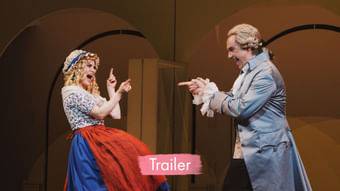
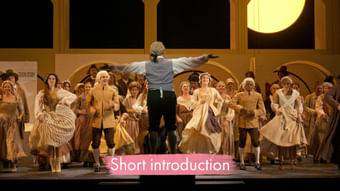
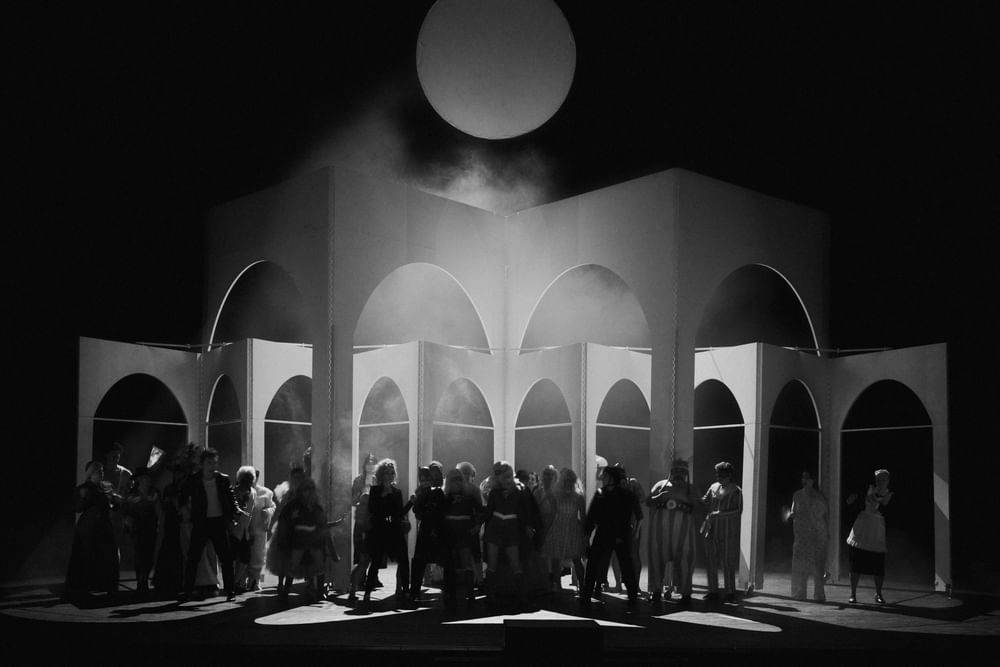
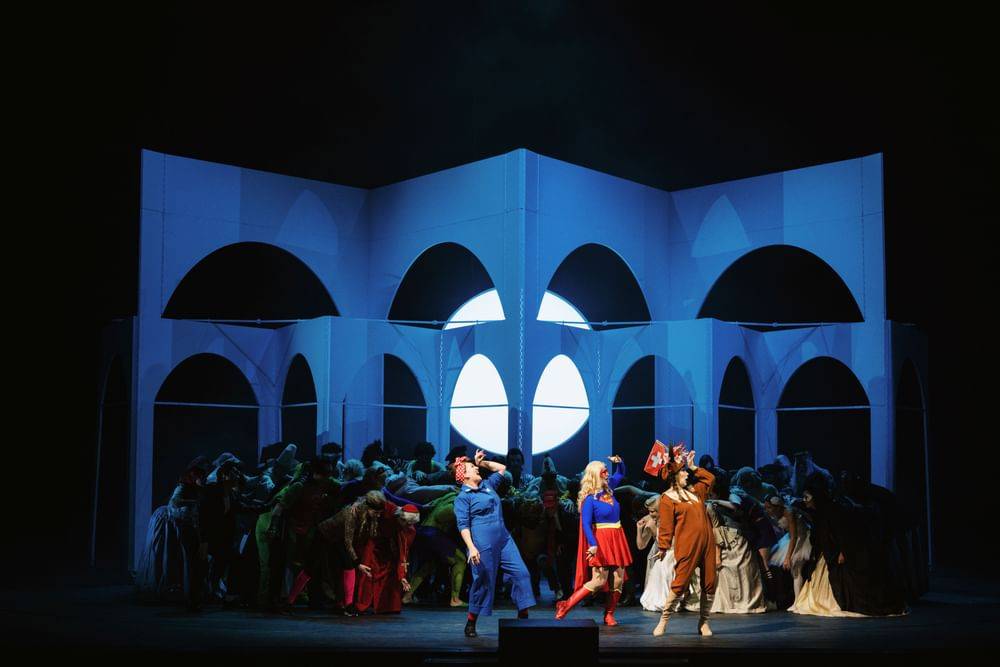
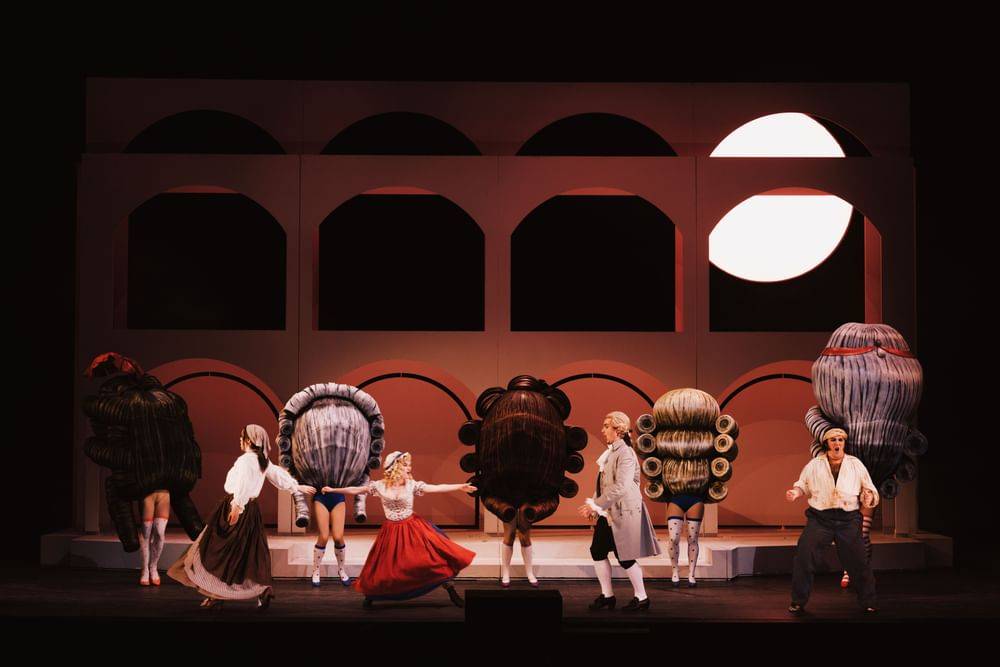
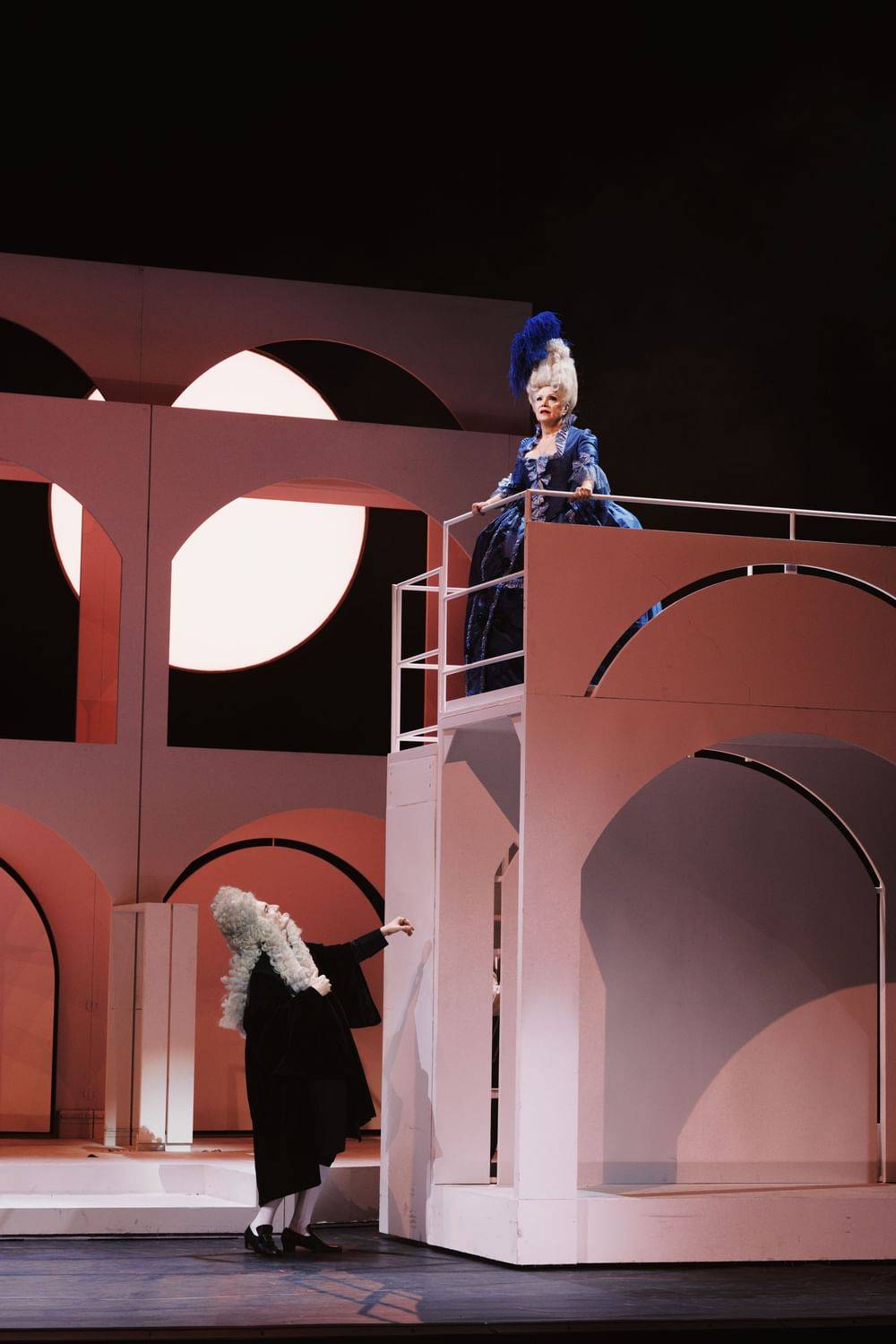
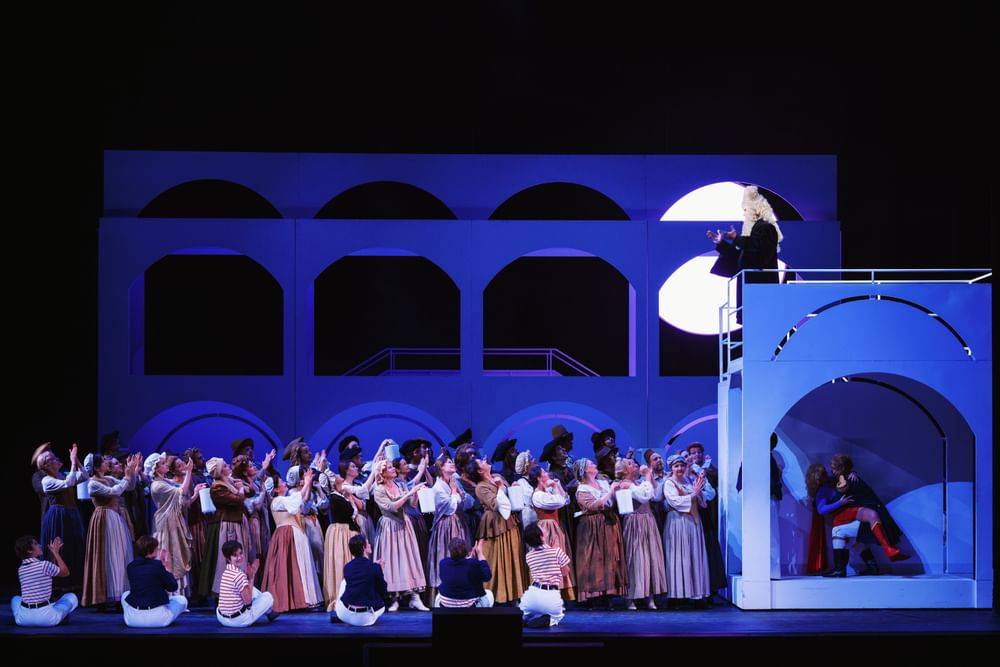
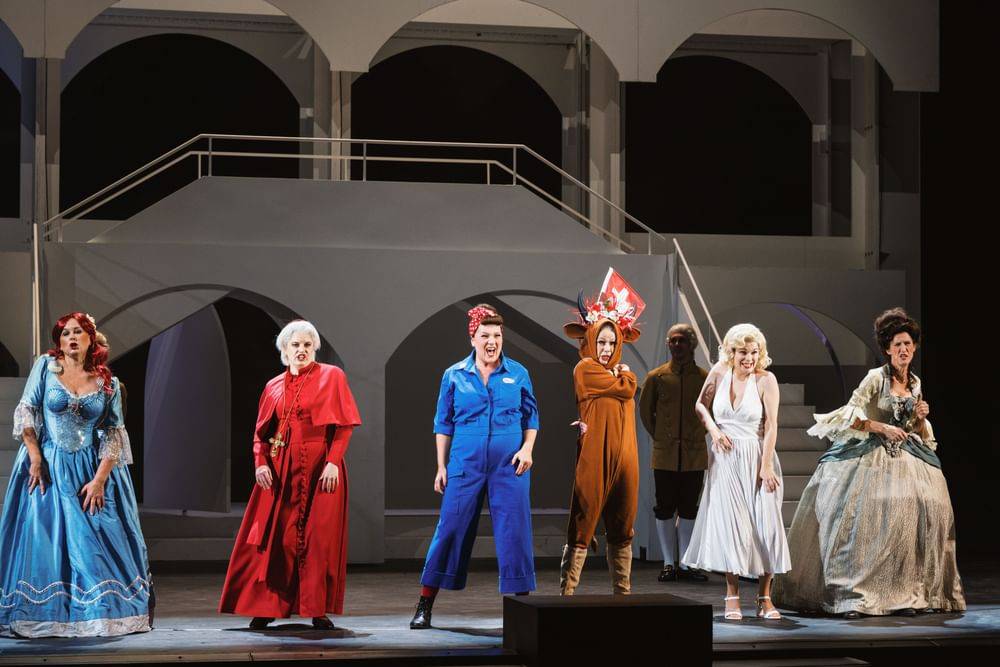
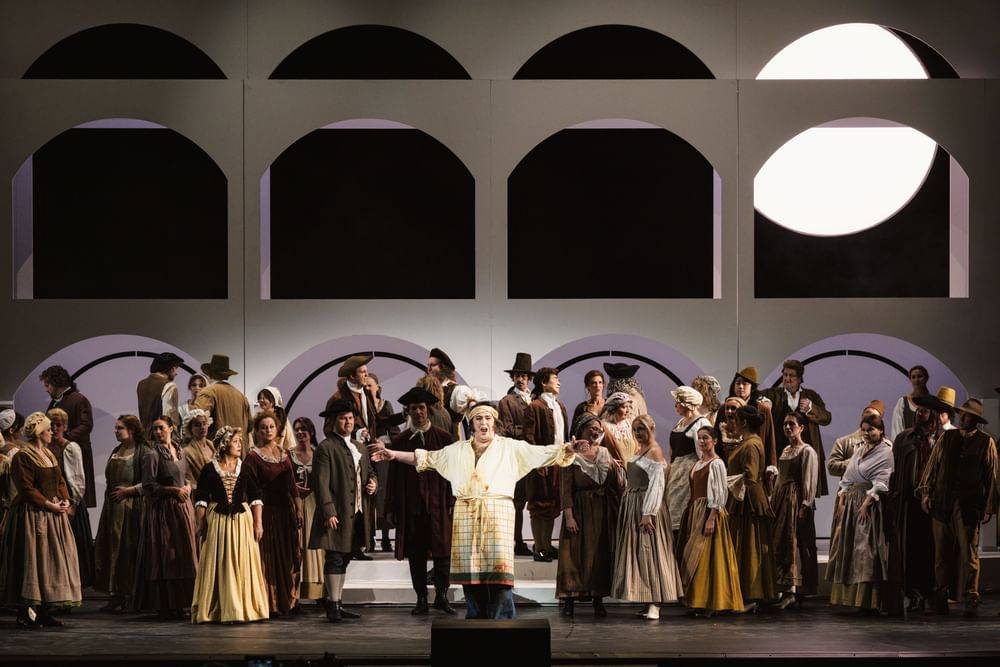
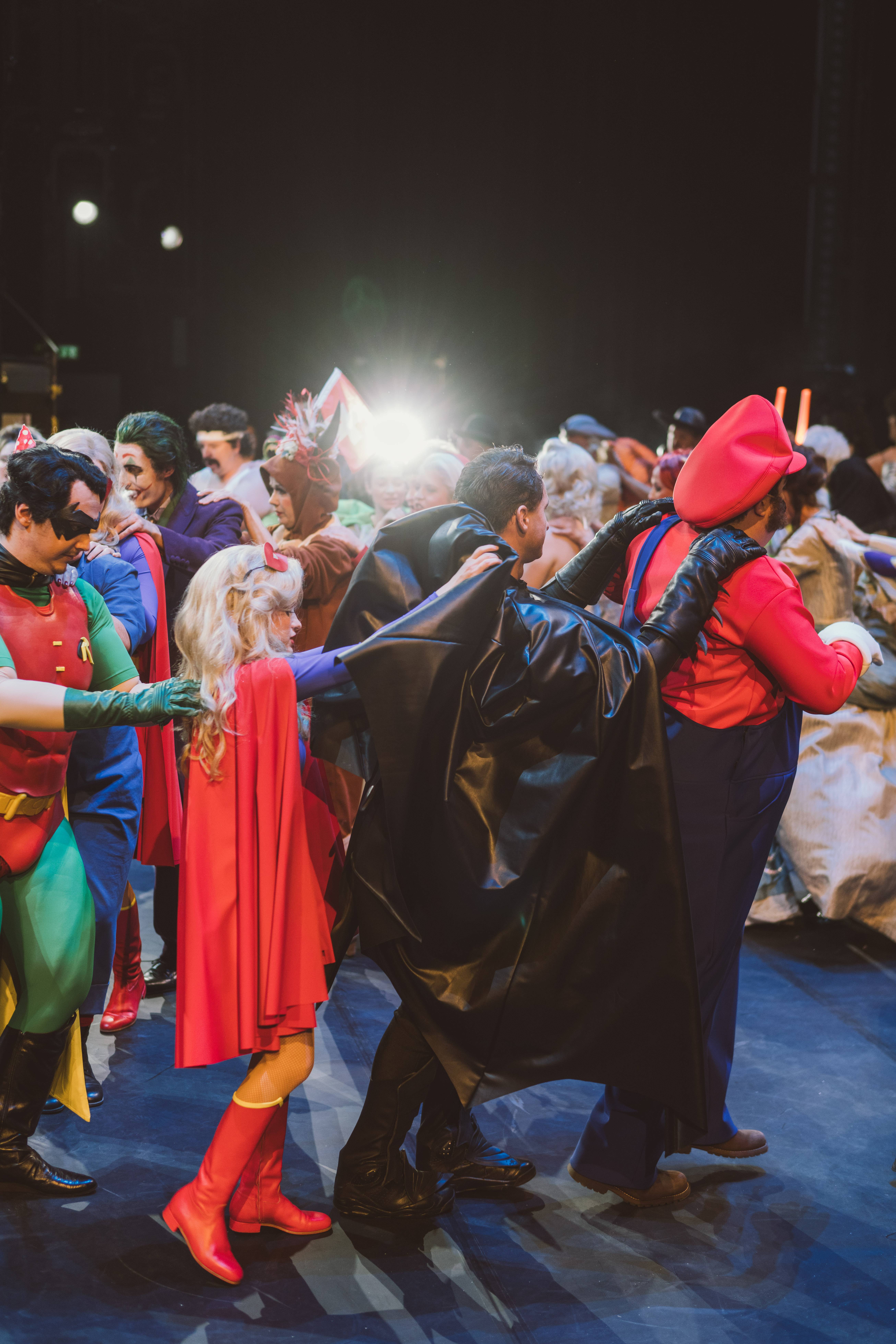
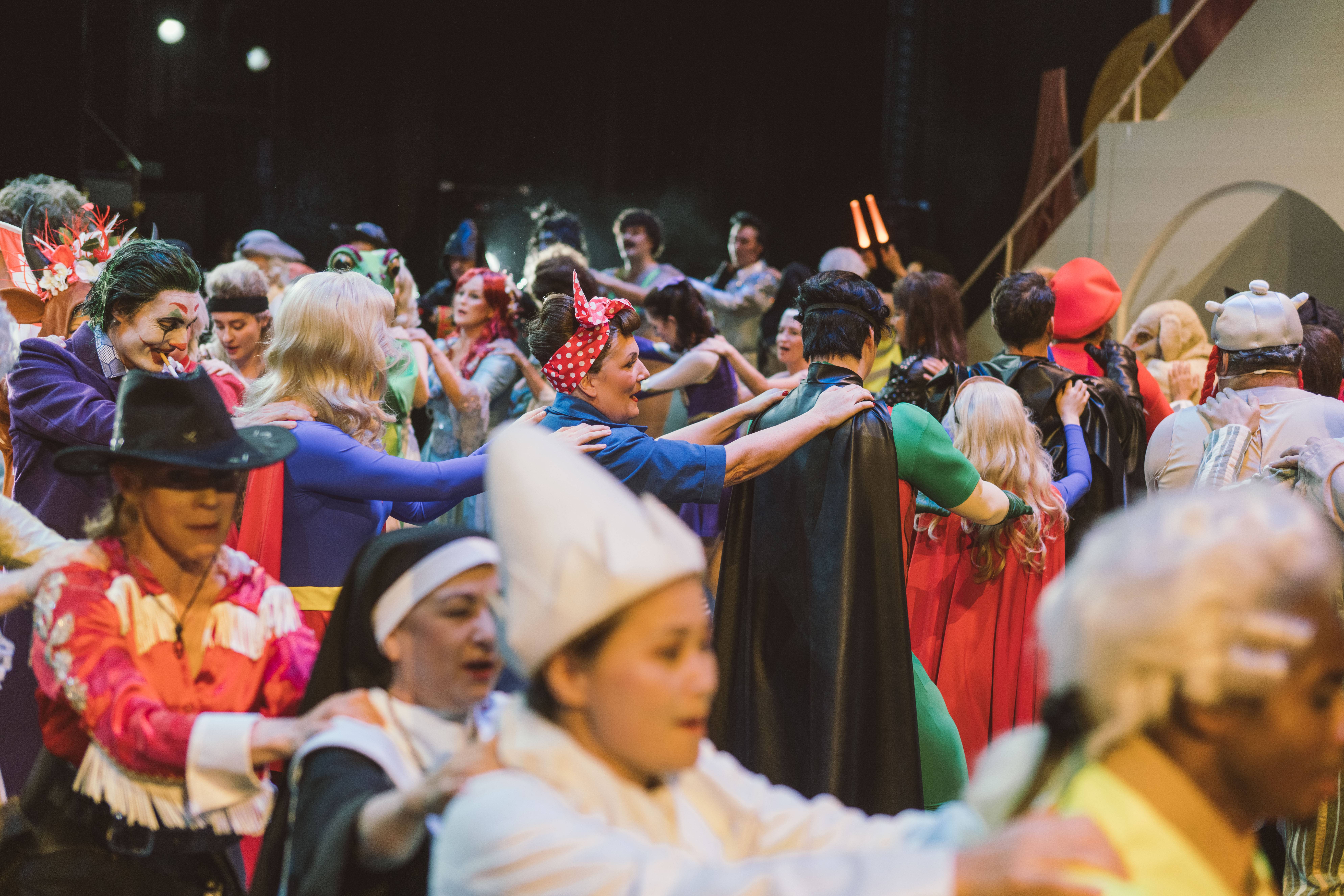
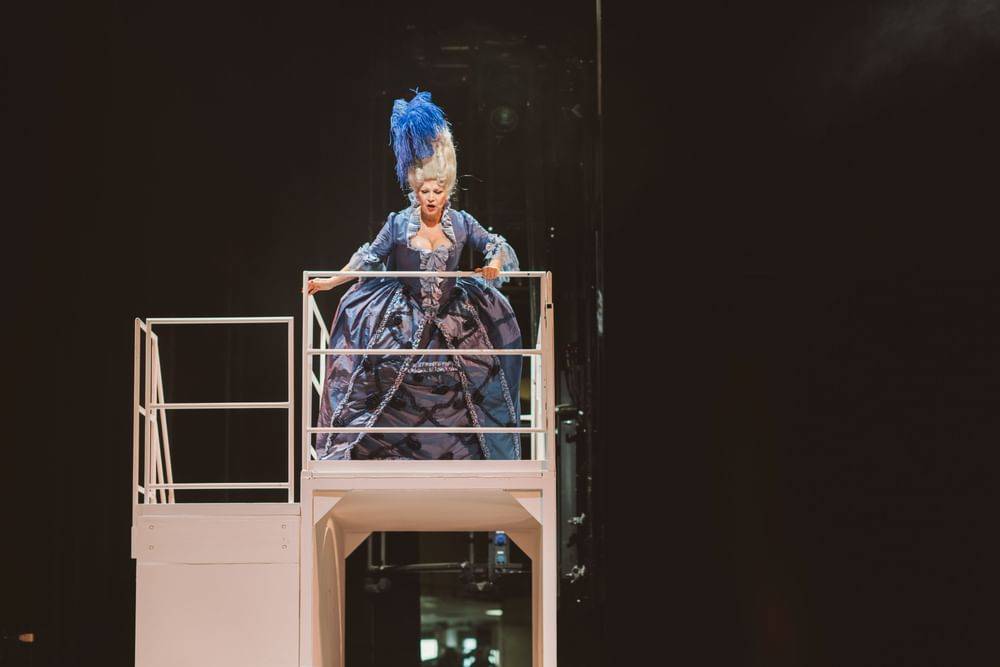
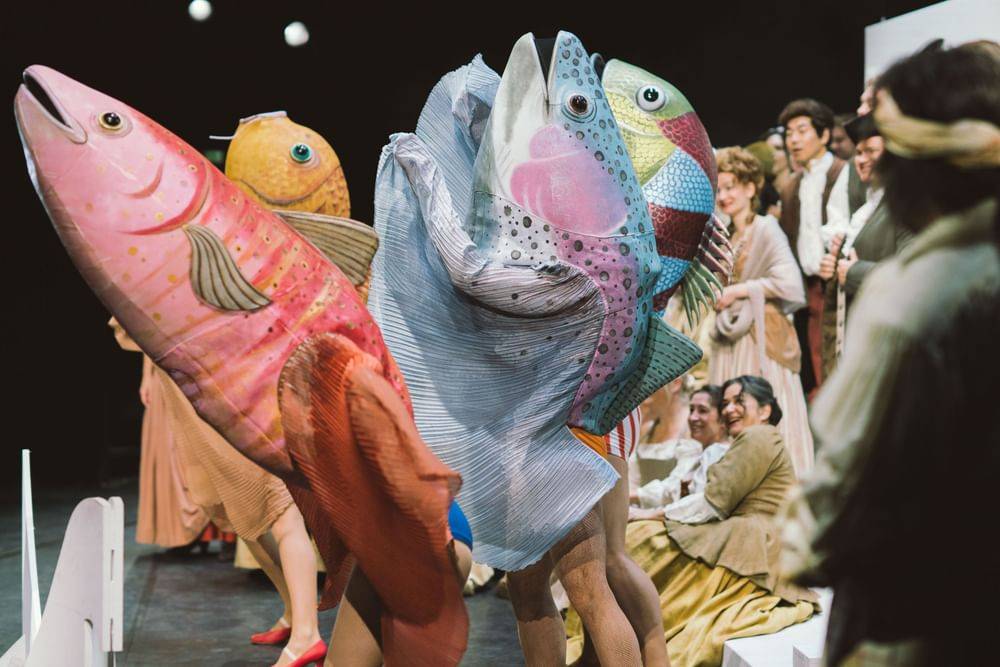
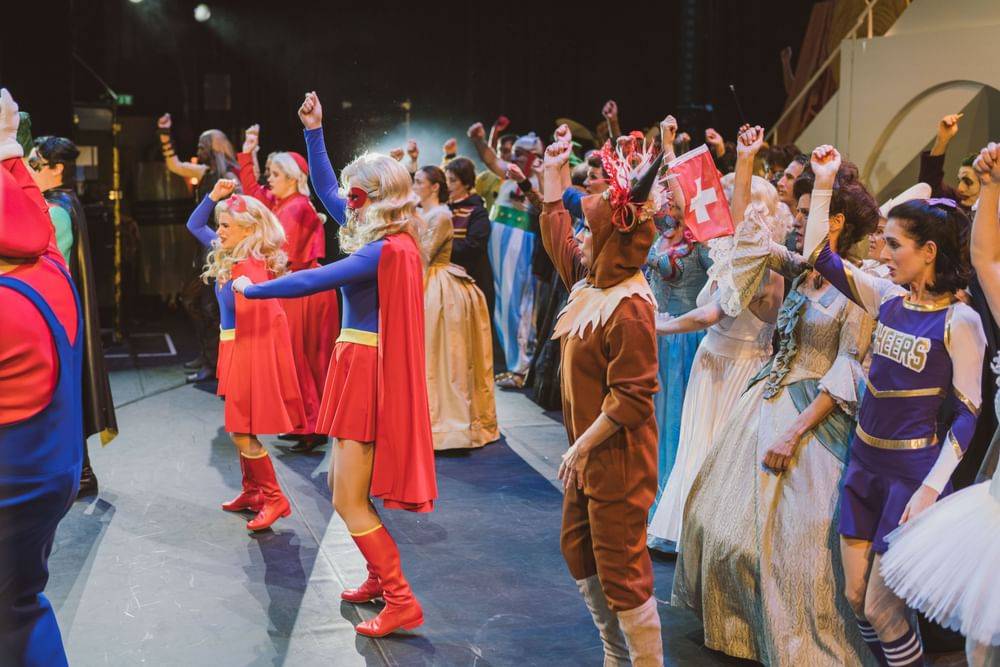
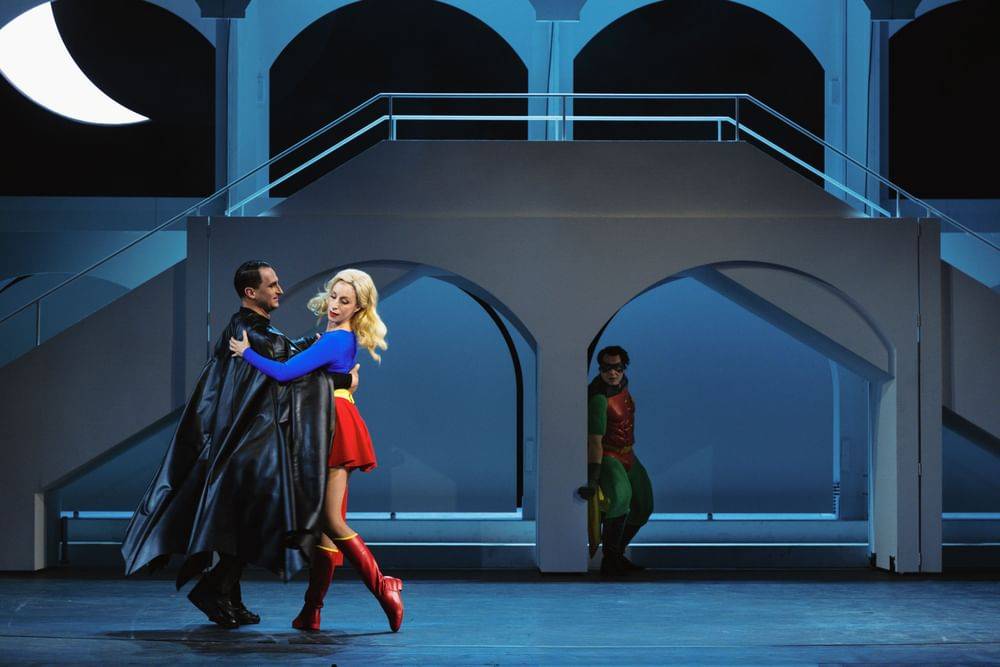
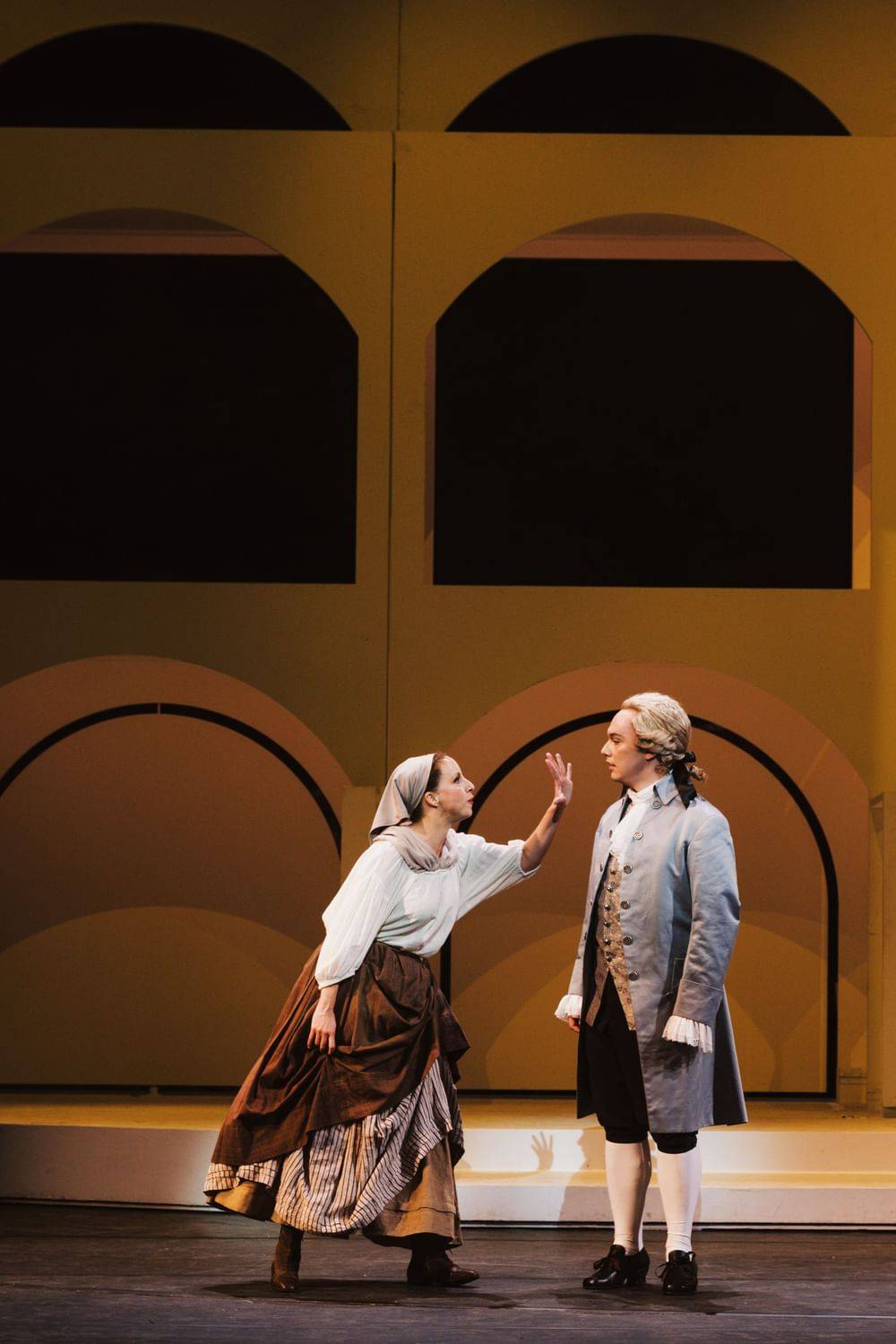
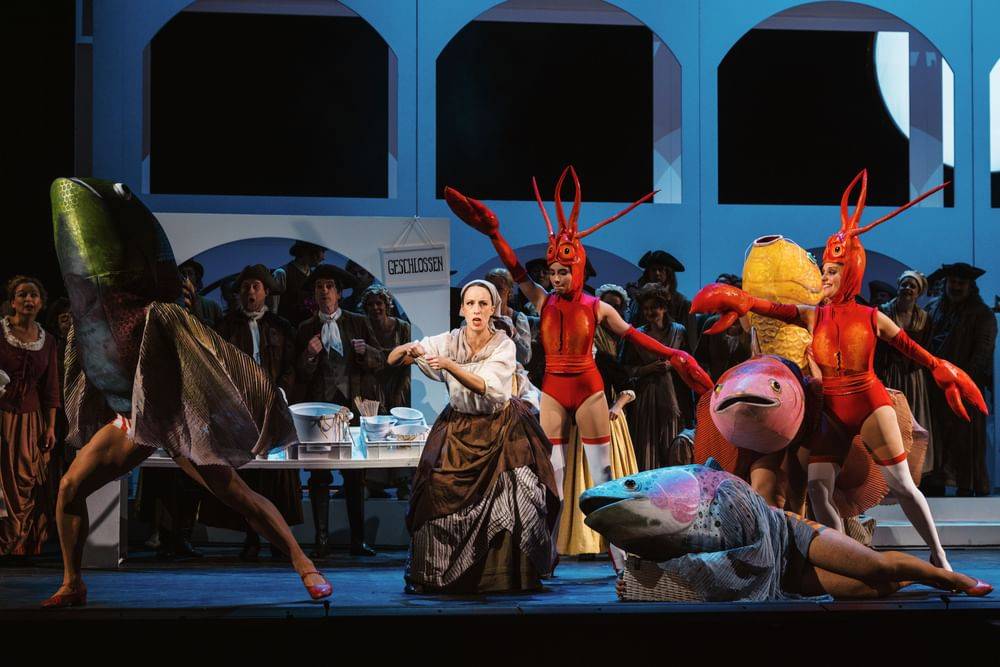
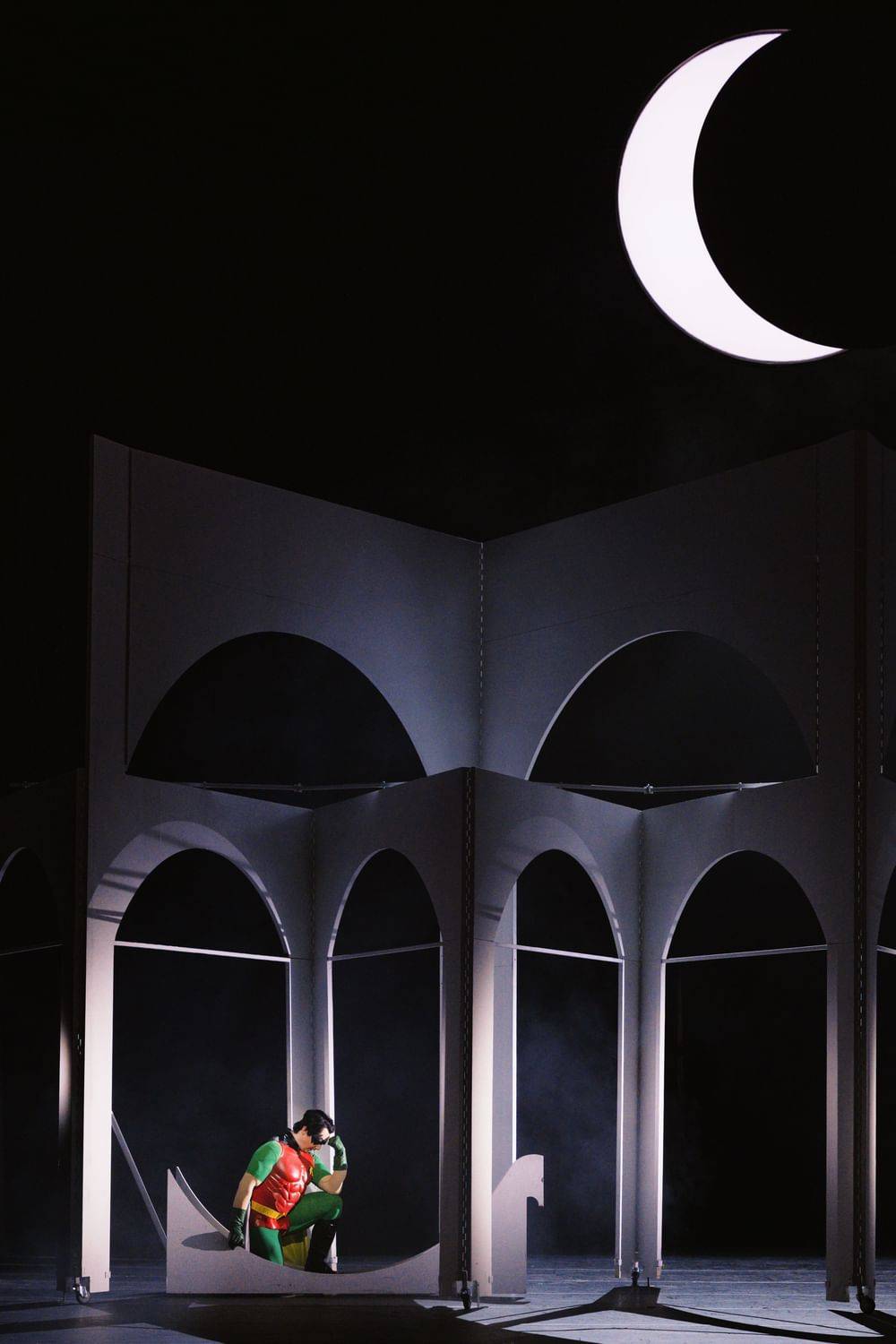
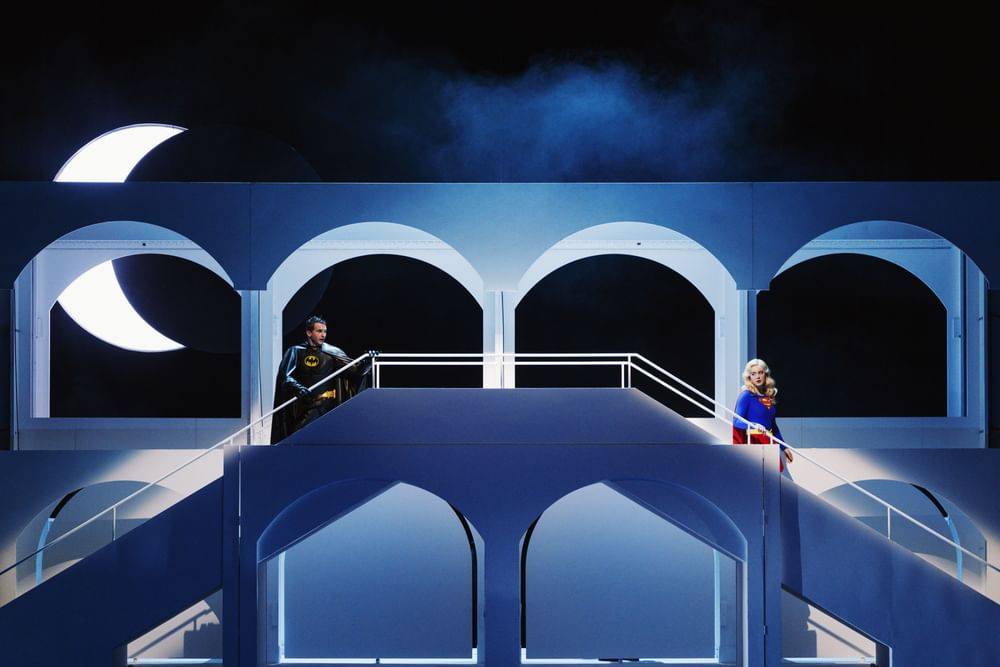
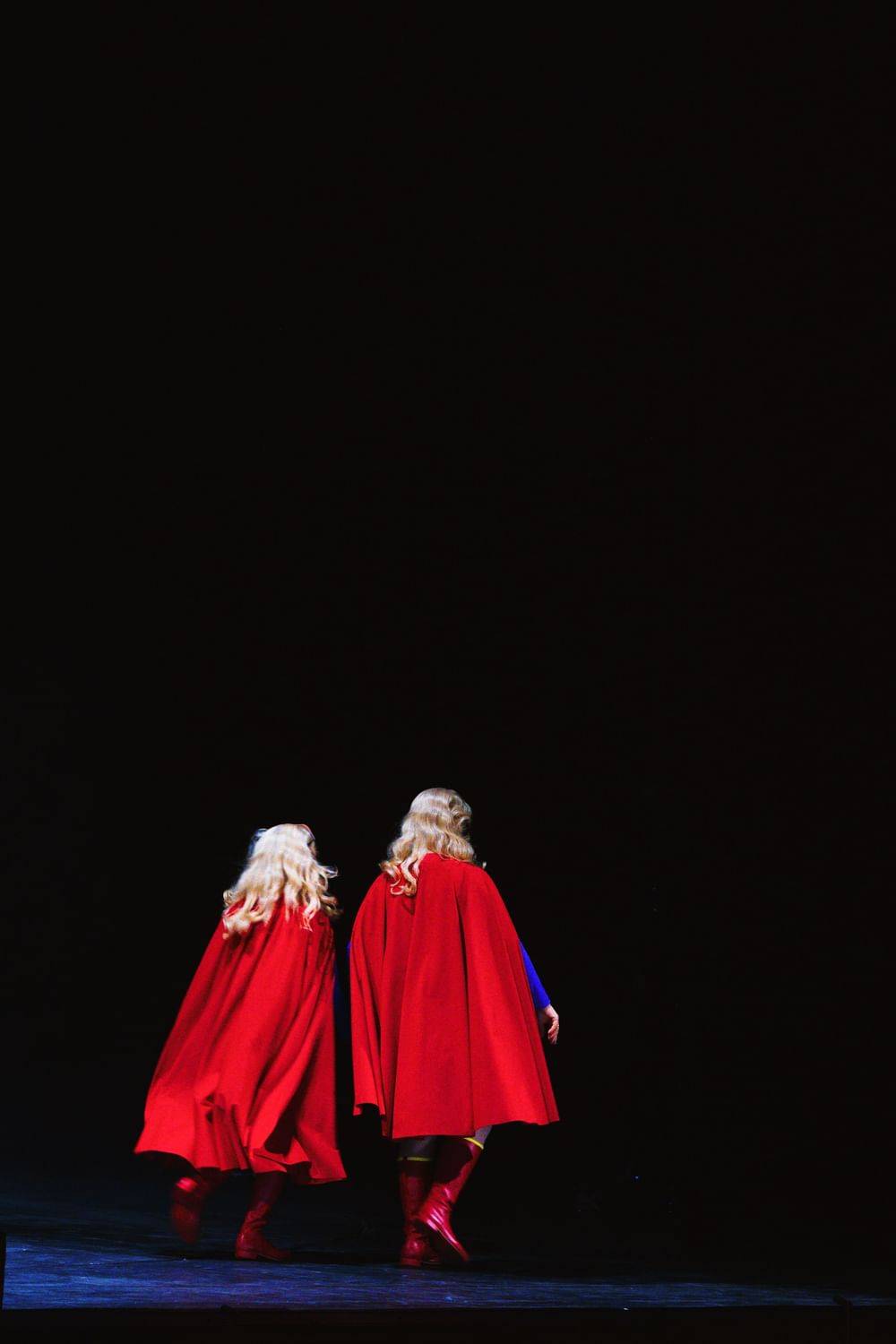
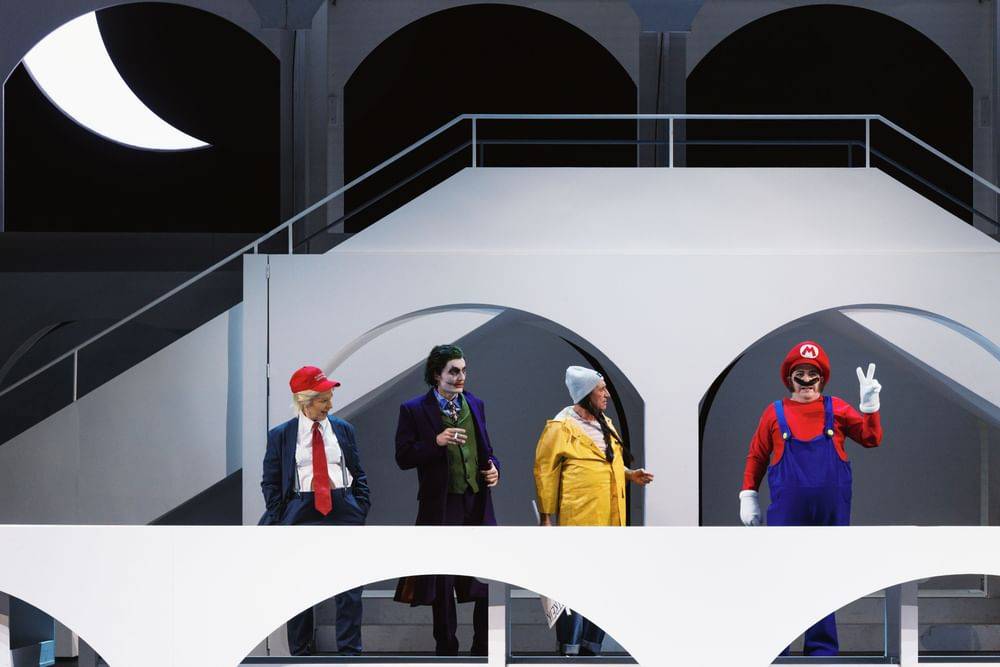
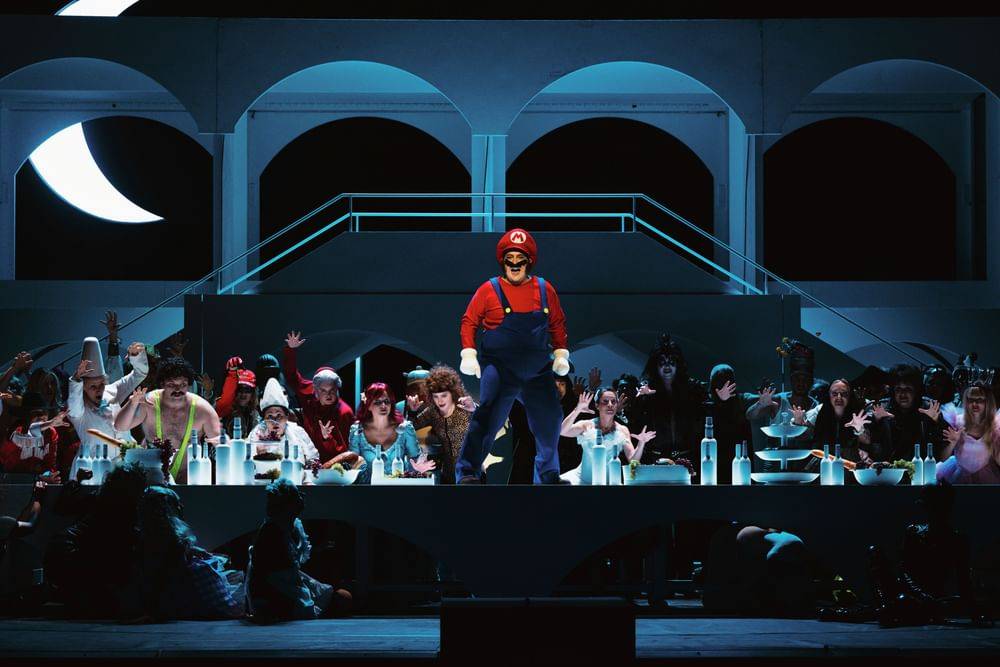
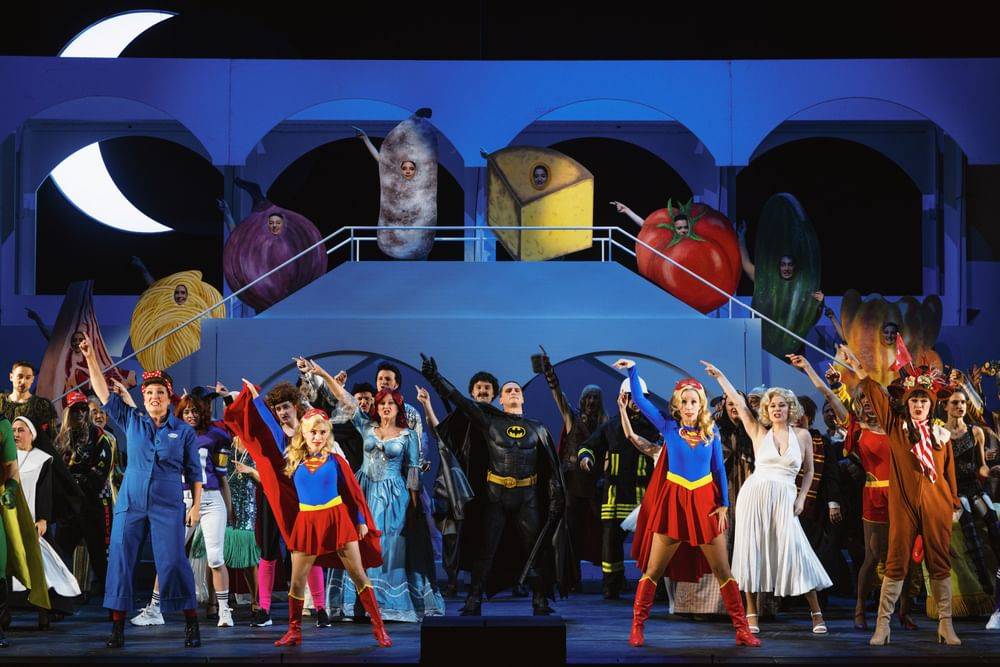
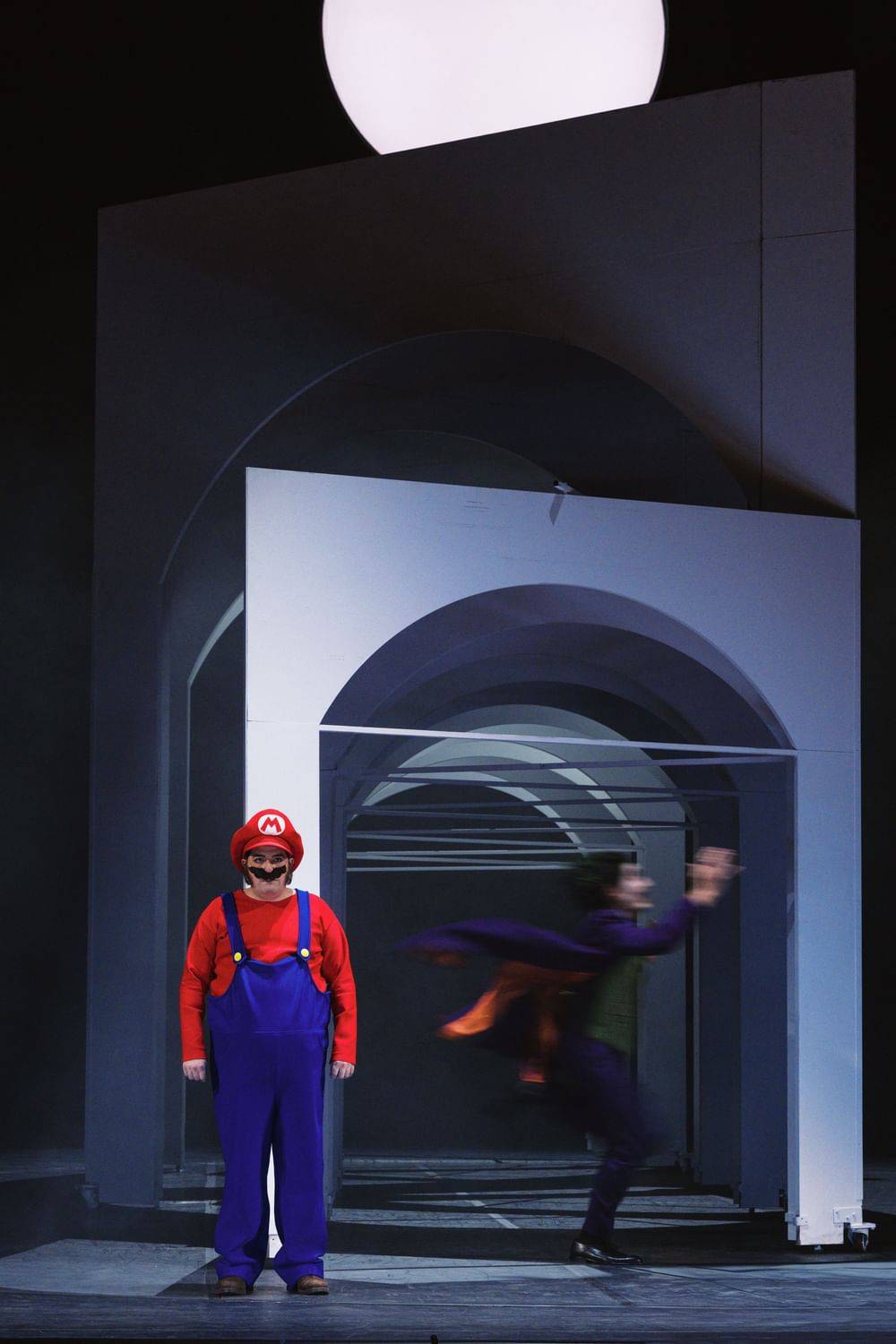
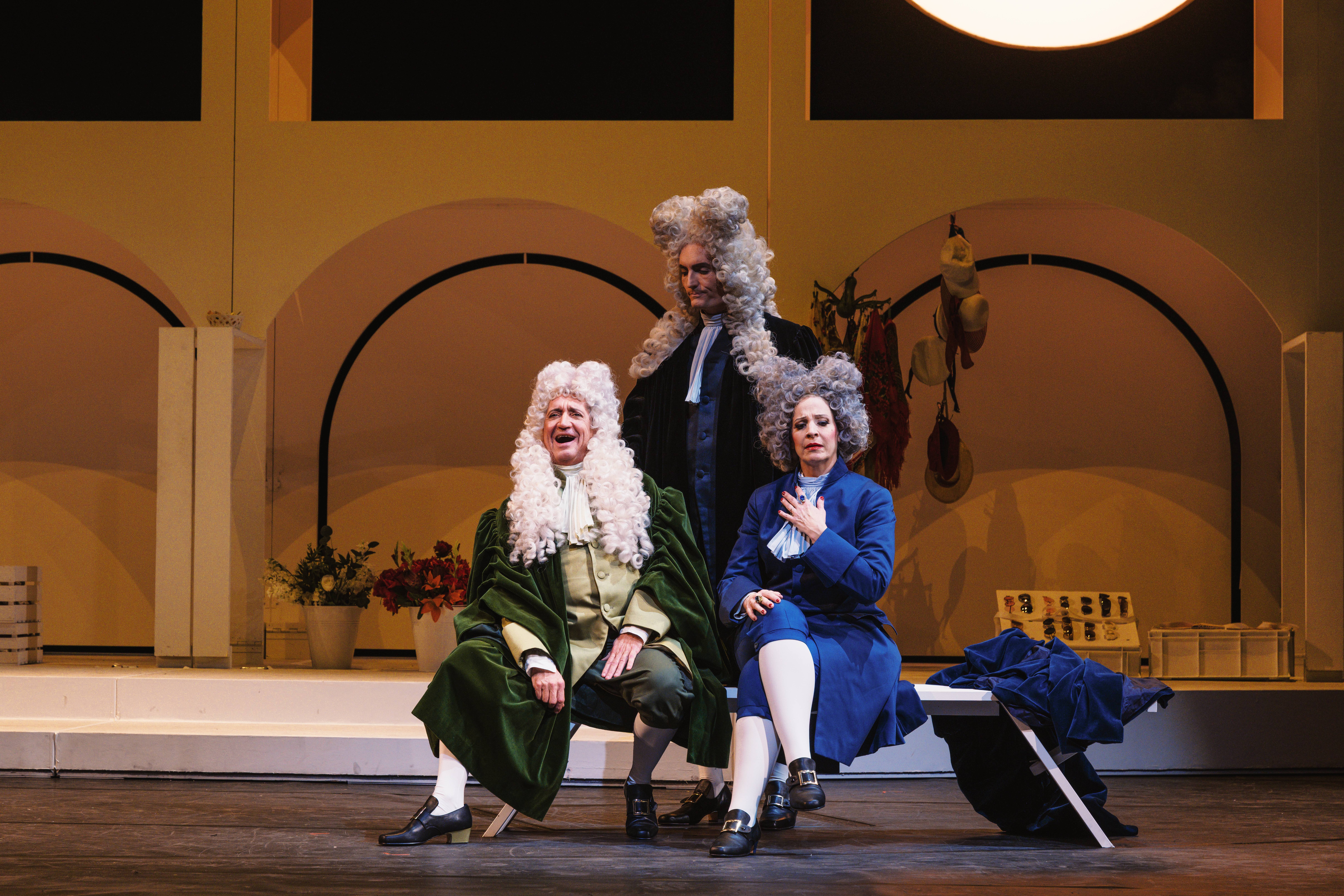
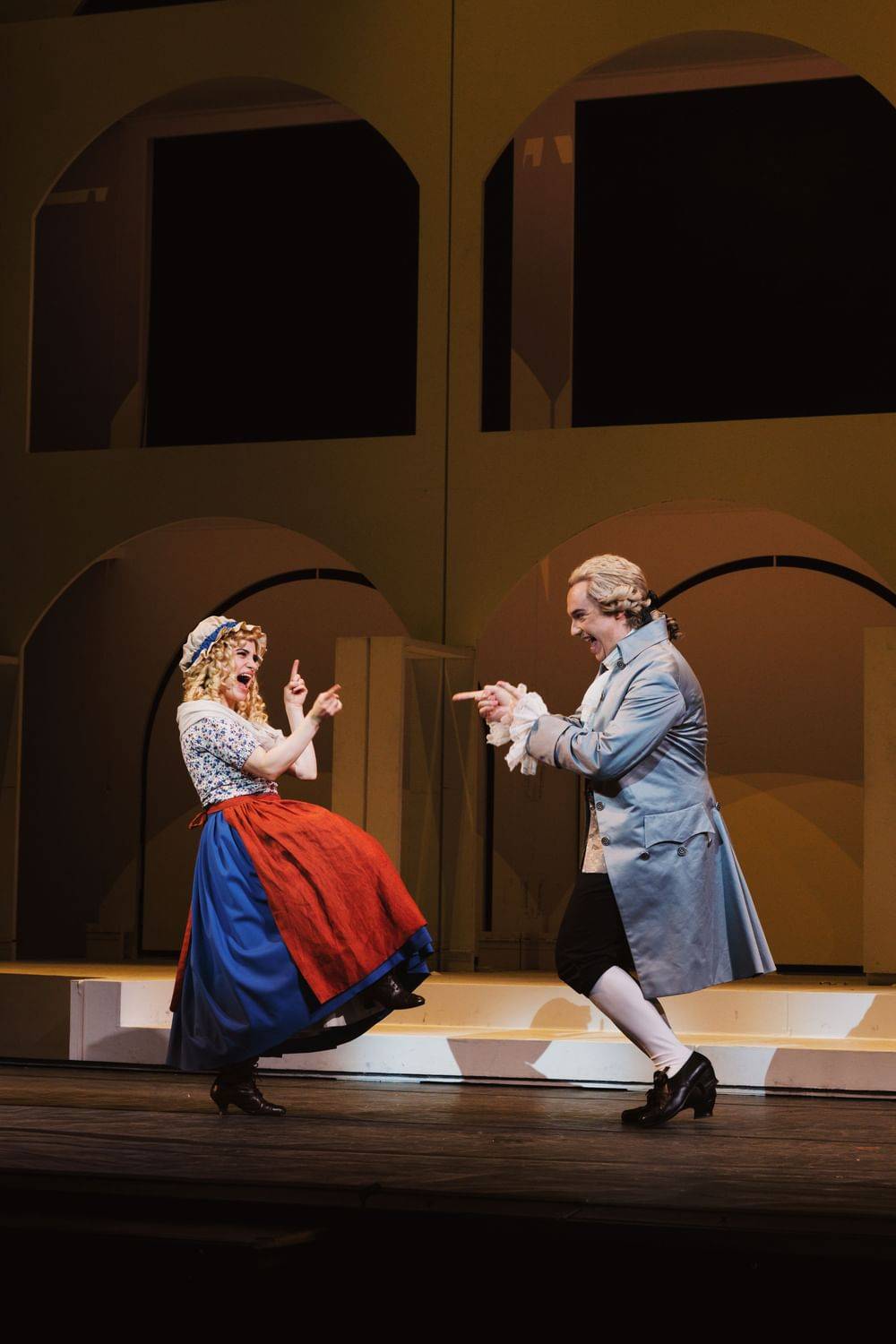
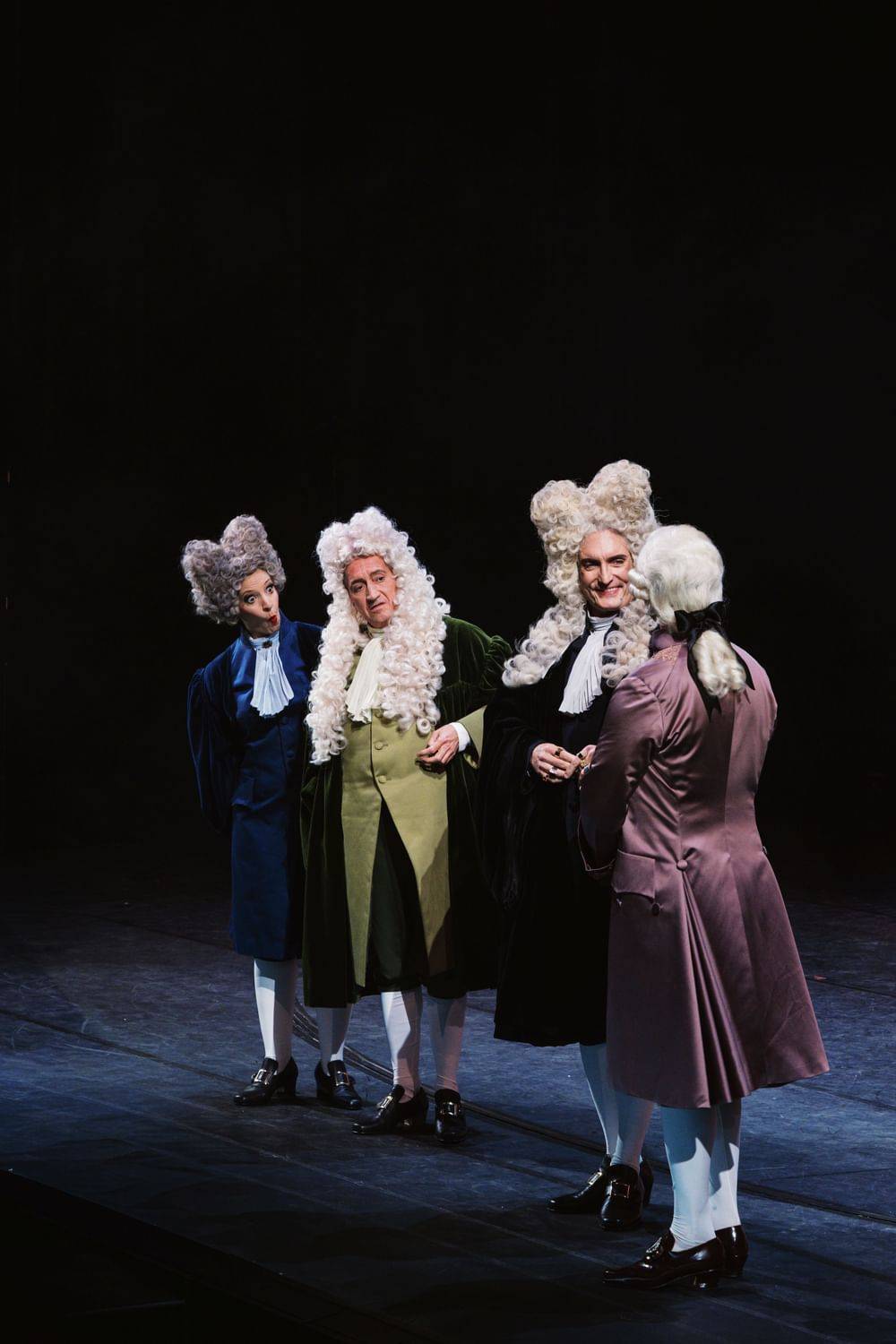
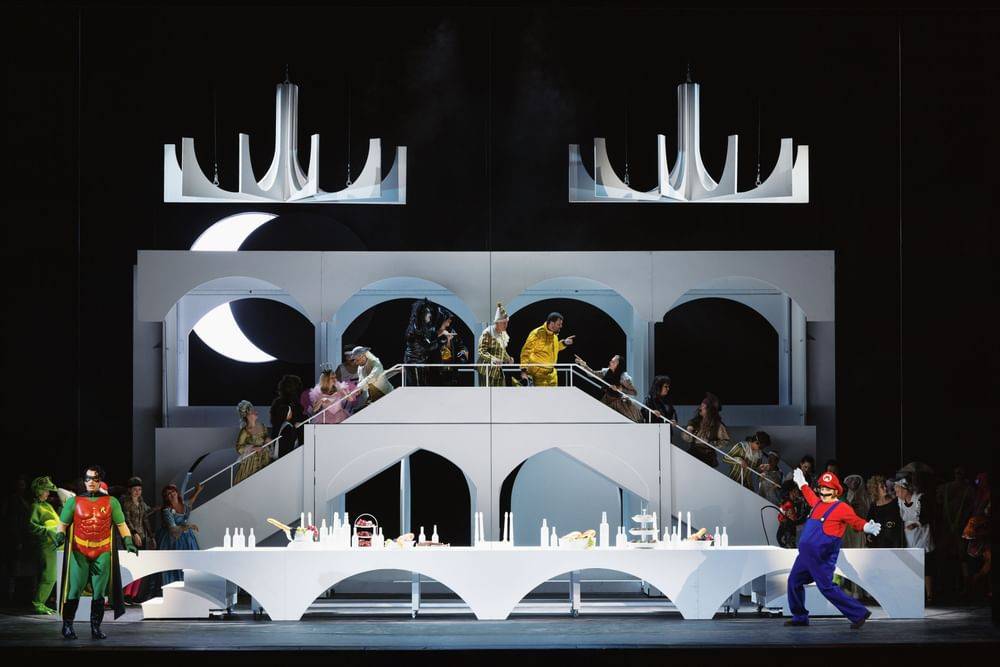
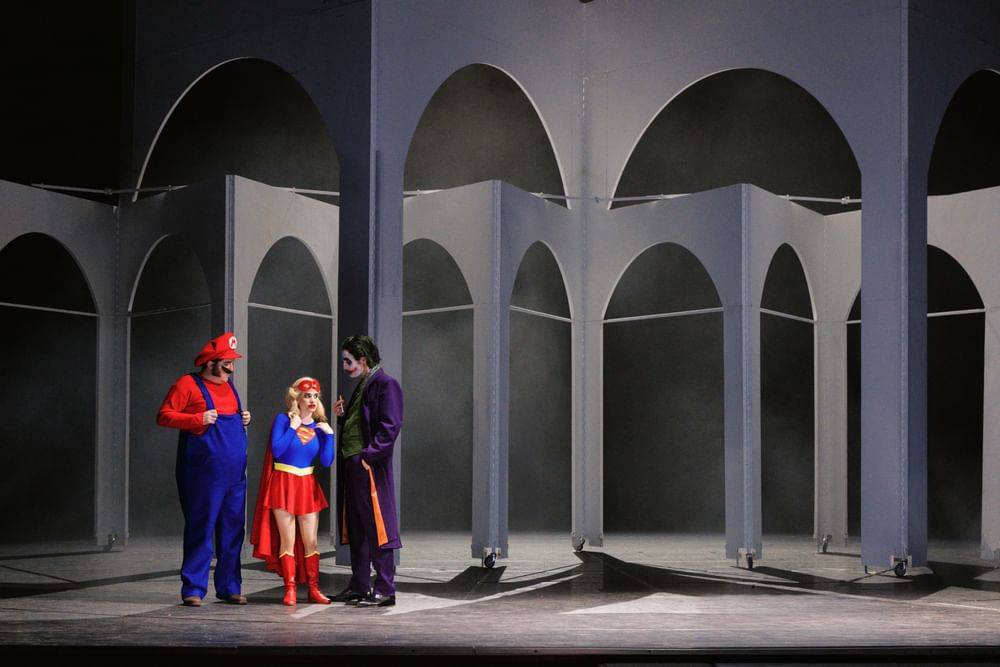
.jpg)
